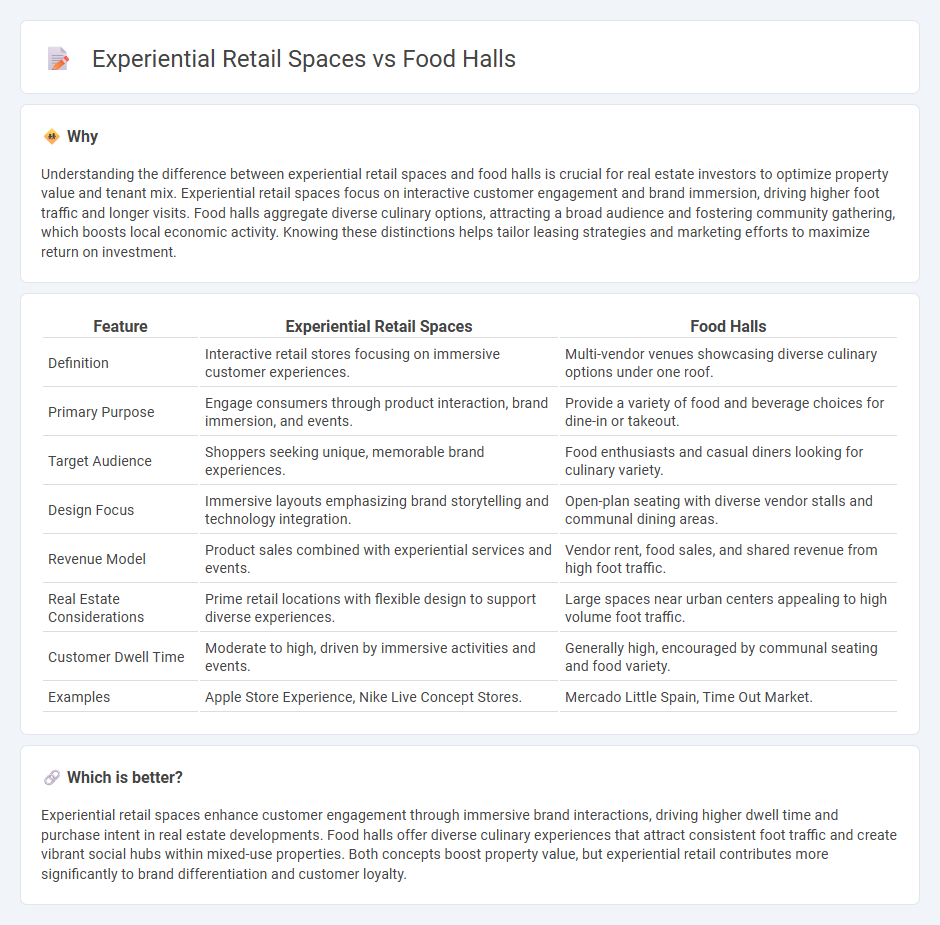
Experiential retail spaces combine interactive shopping with immersive brand experiences, creating engaging environments that attract diverse consumer segments. Food halls offer a dynamic culinary variety under one roof, fostering social interaction and supporting local food entrepreneurs. Explore the evolving impact of these innovative real estate concepts on urban development and consumer behavior.
Why it is important
Understanding the difference between experiential retail spaces and food halls is crucial for real estate investors to optimize property value and tenant mix. Experiential retail spaces focus on interactive customer engagement and brand immersion, driving higher foot traffic and longer visits. Food halls aggregate diverse culinary options, attracting a broad audience and fostering community gathering, which boosts local economic activity. Knowing these distinctions helps tailor leasing strategies and marketing efforts to maximize return on investment.
Comparison Table
| Feature | Experiential Retail Spaces | Food Halls |
|---|---|---|
| Definition | Interactive retail stores focusing on immersive customer experiences. | Multi-vendor venues showcasing diverse culinary options under one roof. |
| Primary Purpose | Engage consumers through product interaction, brand immersion, and events. | Provide a variety of food and beverage choices for dine-in or takeout. |
| Target Audience | Shoppers seeking unique, memorable brand experiences. | Food enthusiasts and casual diners looking for culinary variety. |
| Design Focus | Immersive layouts emphasizing brand storytelling and technology integration. | Open-plan seating with diverse vendor stalls and communal dining areas. |
| Revenue Model | Product sales combined with experiential services and events. | Vendor rent, food sales, and shared revenue from high foot traffic. |
| Real Estate Considerations | Prime retail locations with flexible design to support diverse experiences. | Large spaces near urban centers appealing to high volume foot traffic. |
| Customer Dwell Time | Moderate to high, driven by immersive activities and events. | Generally high, encouraged by communal seating and food variety. |
| Examples | Apple Store Experience, Nike Live Concept Stores. | Mercado Little Spain, Time Out Market. |
Which is better?
Experiential retail spaces enhance customer engagement through immersive brand interactions, driving higher dwell time and purchase intent in real estate developments. Food halls offer diverse culinary experiences that attract consistent foot traffic and create vibrant social hubs within mixed-use properties. Both concepts boost property value, but experiential retail contributes more significantly to brand differentiation and customer loyalty.
Connection
Experiential retail spaces and food halls intersect by creating immersive environments that engage customers through sensory experiences, combining shopping with social interaction and culinary exploration. These dynamic spaces increase foot traffic and dwell time, driving higher sales for retailers and food vendors alike. Integrating diverse food options within retail settings enhances customer satisfaction and encourages repeat visits, boosting overall real estate value.
Key Terms
Tenant Mix
Food halls feature a curated tenant mix emphasizing diverse culinary vendors, local artisans, and specialty food purveyors, creating a vibrant, communal dining experience. Experiential retail spaces prioritize immersive brand activations, interactive product showcases, and lifestyle-centric tenants to enhance customer engagement beyond traditional shopping. Explore the evolving tenant strategies shaping these dynamic environments to understand their impact on consumer behavior and market trends.
Foot Traffic
Food halls generate high foot traffic by offering diverse culinary options under one roof, appealing to a wide demographic seeking variety and social dining experiences. Experiential retail spaces attract visitors through interactive and immersive environments, enhancing shopper engagement and encouraging longer visits. Explore how these distinct strategies drive foot traffic and influence consumer behavior in evolving retail landscapes.
Adaptive Reuse
Adaptive reuse transforms underutilized buildings into dynamic food halls and experiential retail spaces, preserving architectural heritage while meeting modern consumer demands. Food halls often capitalize on communal dining and local culinary diversity, whereas experiential retail spaces emphasize interactive brand experiences and sensory engagement. Explore more to understand how adaptive reuse shapes innovative commercial environments.
Source and External Links
Food Hall - A food hall is a location where various food and drink vendors are gathered, offering a mix of local artisanal and unique culinary experiences.
What is a Food Hall, And Why Do People Love Them So Much? - This article explains the appeal of food halls, highlighting their unique offerings and community-building aspects compared to traditional food courts.
13 Must-Visit Food Halls In The US - This page lists some of the best food halls in the United States, emphasizing their role in providing diverse culinary experiences and fostering community.
 dowidth.com
dowidth.com